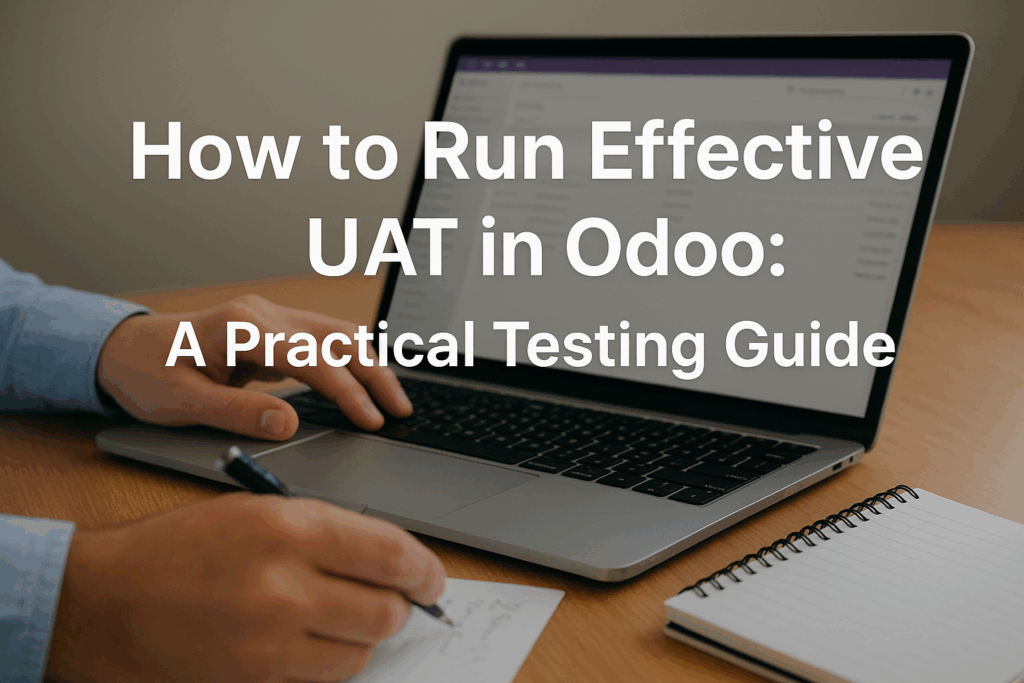How to Run Effective UAT in Odoo: A Practical Testing Guide
Before going live with an ERP system, every business must confirm that processes work as expected. In Odoo, this final stage is called Odoo UAT—user acceptance testing. For companies in the USA and UAE, UAT is more than a checklist. It’s your safeguard against costly errors, compliance risks, and productivity slowdowns. This guide explains how to plan, execute, and validate UAT in Odoo, so you can launch with confidence in 2025.
Why Odoo UAT Matters for Businesses
ERP rollouts fail when assumptions replace testing. Odoo UAT ensures real users confirm that workflows—from sales orders to VAT reports—function correctly before go-live.
In 2025, Odoo has enhanced test environments with better data cloning and role-based simulations, making it easier to replicate real-world conditions. For businesses in the USA, this means validating advanced accounting and regulatory reporting. For the UAE, it’s about confirming VAT handling, multi-currency transactions, and Arabic interfaces. By prioritizing user acceptance testing, companies avoid disruptions and speed up adoption.
Step 1: Define UAT Scope and Test Scenarios
Start by identifying the critical processes your business depends on. UAT isn’t about testing everything—it’s about testing what matters most.
Key Odoo test scenarios to consider:
Order-to-Cash: From creating a sales quote to issuing an invoice.
Procure-to-Pay: From purchase requisition through vendor payment.
Inventory Management: Stock updates, transfers, and valuation.
Financial Closing: Trial balances, reconciliations, and tax submissions.
Engage process owners in designing these scenarios. Their insights ensure the tests reflect daily operations, not just system features.
Step 2: Prepare Data and Test Environment
Accurate results depend on realistic test data. Use anonymized but representative customer, vendor, and product records. Odoo’s 2025 sandbox features now allow faster duplication of production data while masking sensitive information—ideal for businesses handling cross-border transactions in both the USA and UAE.
Also, ensure roles and permissions match real-life structures. For instance, a UAE finance manager testing VAT reports should see only the relevant modules, not full system access. This mirrors how the ERP will operate after go-live.
Step 3: Execute UAT with Clear Acceptance Criteria
During execution, assign scenarios to end-users and track results systematically. Define pass/fail criteria before testing begins. For example:
A sales order should generate the correct tax automatically.
A purchase order should update vendor ledgers instantly.
A general ledger report should match the uploaded opening balances.
This structured approach transforms UAT from trial-and-error into actionable validation. Encourage testers to document issues clearly, with screenshots and expected outcomes.
Step 4: Review Results and Plan Go-Live Testing
After execution, consolidate findings and classify them by severity. Critical issues—such as incorrect tax posting—must be resolved before go-live. Lower-priority fixes can be scheduled for later phases.
As part of Odoo go-live testing, run a final “day-in-the-life” simulation: process actual transactions, close a mock month, and confirm reporting accuracy. This builds trust among leadership and employees that the system is truly ready.
Linking UAT outcomes to a broader Odoo implementation guide ensures lessons learned feed back into future rollouts and upgrades.
Conclusion
Effective Odoo UAT bridges the gap between system setup and real-world performance. By defining the right test scenarios, preparing accurate data, setting clear acceptance criteria, and validating with go-live simulations, businesses in the USA and UAE can launch Odoo with confidence in 2025.
Ready to make your Odoo go-live seamless? Partner with OdooVizion to design and execute UAT that ensures a smooth transition and long-term ERP success.

